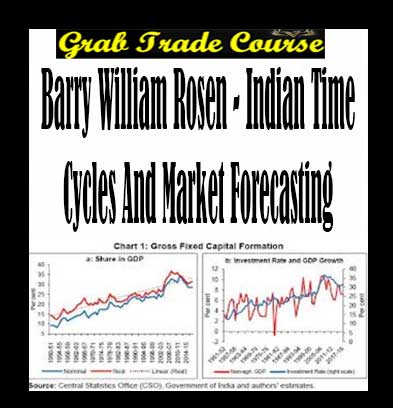Barry William Rosen – Indian Time Cycles And Market Forecasting
Description
Indian Time Cycles And Market Forecasting, Barry William Rosen – Indian Time Cycles And Market Forecasting, Indian Time Cycles And Market Forecasting download, Barry William Rosen – Indian Time Cycles And Market Forecasting review, Indian Time Cycles And Market Forecasting free torent
Barry William Rosen – Indian Time Cycles And Market Forecasting
Barry William Rosen – Indian Time Cycles and Market Forecasting (Article)
It is a little known fact that W. D. Gann went to India and studied Indian Sidereal Astrology. In his notebooks we find sketches of astrological symbols on his charts; and in his memoirs, he discusses his journey to India. In fact, the famous Gann wheel was first used by tea merchants in seventeenth century India.
Gann also discussed the importance of using the starting date of when the first futures contract for a commodity began trading for predicting the future of that commodity. To my knowledge, there are very few individuals who use these starting dates to successfully time the markets even though my experience in using Indian Sidereal astrology has shown that these charts are invaluable. If one can verify the starting time and date of the first futures contract for a commodity, and run an Indian Sidereal natal chart from it, then that chart can provide absolutely valid information for predicting, quantifying, and labeling the major and minor cycles that ultimately govern the major trends in the markets.
Below is a brief introduction to Indian Sidereal Astrology how I became acquainted with it. The three main sections are:
–an overview of the Vimsottari Dasha system (which I will subsequently refer to as Indian time cycles).
–the practical application of using Indian time cycles for predicting the major movements and changes in those movement in the stock market.
–and, a forecast for the future of the stock market based on Indian astrological time cycles.
EARLY RESEARCH BEGINNINGS
I first became interested in Indian astrology in 1985, when a jyotishi (Indian astrologer) told me that I was finishing up a twenty-year Venus cycle, and that my life would completely change in one year when I would enter a new six year Sun cycle. I was told that I would become famous, make great advances in my career, change professions and locations, and emotionally change from a depressing period, into one that was more jubilant and optimistic. And surprisingly, one year later, that is exactly what happened. I went from being an instructor in film studies in Bloomington, Indiana to studying Indian astrology, investments and commodities, and moving to southeastern Iowa. My ability to forecast my own life and those of my friends very accurately led me to apply Indian astrology to the markets. This connection became especially exciting when a friend of mine, who was a Gann expert, told me of Gann’s interest in Indian astrology.
The Western Zodiac vs. the Indian Zodiac
Indian astrology is over 5000 years old and has its foundation in ancient science. Parashara, a great seer or ancient scientist, intuited the laws of space and time responsible for the evolution of human consciousness and recorded his findings in a book called the Brihat Hora Sastra. As with all knowledge in book form, over time, the knowledge became fragmented and lost, as it migrated to various other cultures and became distorted. In its purest form, however, Indian astrology has always been acknowledged for its predictive abilities; whereas, Western astrology (with the notable exception of Medieval astrology) has excelled in its analytical and psychological insights.
The first major difference between Indian and Western astrology lies in the calculation of the longitude of the planets. Ancient Indian astrologers observed that the equinoxes and solstices moved backward by one degree every 72 years, an astronomical phenomenon now known as precession. Over time this has resulted in a difference of slightly over 23 degrees between the tropical Zodiac, used by Western astrologers, and the sidereal Zodiac, used by Indian astrologers. In essence, the two systems differ in their choice of a zero point for Aries –the Western system uses the position of the spring equinox, while the Indian system uses a fixed star. Thus when the Sun is moving into Aries according to the Western system, it is still at 6 degrees Pisces in the Indian system. (For a further discussion of the differences, please see my article in the Winter 1989 NCGR Journal.)
Planetary Periods: Beyond Transits
A dasha is a period of time during which one’s life is influenced or governed by a particular planet. For example, the shortest period, the Sun period, lasts for six years, while the longest period, Venus, lasts for twenty years. These cycles unfold in a fixed sequence and comprise 120 years before they repeat and begin again. The order of the cycles is:
Ketu (Moon’s South Node): 7 years
Venus: 20 years.
Sun: 6 years.
Moon: 10 years.
Mars: 7 years.
Rahu: (North Node) 18 years.
Jupiter: 16 years.
Saturn: 19 years.
Mercury: 17 years.
Where the cycle begins is based on what lunar mansion or constellation the moon is in at the time of birth. For example, when soybeans started trading in 1936, the moon was in the constellation (nakshatra) of Orion, which is ruled by the planet Mars. Thus a sequential unfoldment of cycles began with a seven years Mars period followed by Rahu (North Node of Moon), 18 years, Jupiter 16 years, into its current Saturn period that lasts 20 years etc. If beans had begun trading a day later, then the cycle would have begun from the next constellation, which is ruled by Rahu or the North Node of the moon. The number of degrees the moon has transited through a nakshatra will determine how much time is left in the initial cycle. Thus if the moon were in the final degree of the constellation, the initial cycle will begin in the last section of the cycle. (Software is available for rapid computer calculation of these cycles–see references.)
Within major cycles are sub-periods or subcycles that also unfold in a set sequential pattern. The subcycle begins with planet ruling the major cycle and then continues in sequence.For example, the current Saturn period for soybeans started with a Saturn/Saturn period in Sept. 1979, and continued with a Saturn/Mercury period in Sept. 1979 followed by a Saturn/Ketu period etc. The major Saturn cycle will finish in 1996 and then soybeans will move into a major Mercury cycle starting with Mercury/Mercury, Mercury/Ketu, Mercury/Venus etc.
In order to properly use the Indian time cycles and their smaller periods, one must have the exact time of the start of the first future’s contract of a commodity. Each minute that one is off can lead to changing the prediction low or high by 4 days. O’Non and Remnick illustrate the importance of the exact time using a brilliant analogy from physics:
To launch a rocket ship to the moon, knowledge of the precise angle, time, and location of the launching on earth are necessary. If it is launched at a slightly different time and angle, it will miss by 30,000 to 40,000 miles.
I have had to travel to the archives of the Chicago Board of Trade and other major exchanges to verify the first tick starting time and have collected an almost complete set of dates and times which I make available to participants in my advanced seminars.
Predicting the effects of the period is based on the natal chart placements at the time of birth. The positive or negative nature of these periods depends on the placement of the planet by house position, the houses he owns, the houses he aspects, the planets that aspect him, and the sign that he is in. For example, in a person’s natal chart that has Jupiter in Cancer in the 9th with Scorpio rising, a speculator in a Jupiter period lasting 16 years would expect astounding results, since Jupiter owns the 5th and the 2nd (speculation and accumulated wealth) and is exalted in the house of good luck and good fortune. Indian astrology is thus especially fruitful for looking into ones own chart and seeing what periods will bring the most good luck and good fortune. W.D. Gann was noted for emphasizing the importance of trading off of ones chart. My own experience has supported this notion. Even when my market timing is on, if my own chart suggest losses or obstacles in the cycles, I inevitably get bad fills, miss a major entry by a tick, or get stopped out before the market goes my direction.
In Indian astrology cycles are stronger than transits and aspects. This concept can explain why some Western astrologers are frustrated in their analyses. According to Indian astrology if the underlying period is positive, then bad transits or aspects will only have a minor negative effect; if the underlying period is negative, even good transits or aspects may not make a dent. In market terms the cycle or dasha often represents the underlying market sentiment. For example, in a bear market, when there is good news and the market fails to rally, the underlying sentiment remains bearish and no external event is going to alter it. More concretely one can remember well the Saturn/Uranus conjunction of Feb. 1988 that was forecasted to suggest a sequel to Black Monday. However, it failed to manifest, not only because of a special planetary combination (yoga) from Jupiter’s trinal aspect on its own sign, but also because the underlying period, Jupiter/Mercury/Sun, was neutral to slightly positive.
APPLICATION OF THE INDIAN CYCLES TO STOCKS
What is extraordinarily exciting about using dashas or Indian time cycles for market prediction is that it allows one to know the exact date that cycles change, to label them, and to quantify whether they are strong ups, minor ups, strong downs, or sideways. If one studies the 204 year history of the stock market, and is familiar with the rules for predicting and interpreting the Indian dasha or time cycle system, the mysterious cycles which seem to govern stocks would no longer be a mystery. For example, by no accident the bull market that began in 1982 coincided with the beginning of a 16-year Jupiter period, which began in late August. In general then, according to this system the market would continue to expand until 1998, since Jupiter is a “bullish” planet and is well placed in the natal chart of the May 17, 1792 stock market chart. Rises and falls within the current Jupiter cycle are explained by sub-periods, or antardasas. These sub-periods can either amplify or diminish the strength of the major period.
Within this 16-year period, the transits of Jupiter, its retrogradation and aspects to it are especially influential since Jupiter assumes the second most important role in the NYSE chart next to the moon, the chart lord. The Jupiter period ended in 1998, when a 19-year Saturn period assumed the second most important role.
A recent study I did of the NYSE will explain how the dashas can be of use to spot short- term and intermediate declines or rises. Certain combinations lead to very predictable outcomes. To get daily timing on the stock market, one needs examine four or five levels of dashas or cycles to break the larger 20- and 2-3-year periods down into 20- and 3-4- day periods. Amazingly, the cyclical combinations that are negative on the larger scale level will often prove negative on the smaller scale.
A comparison of the October-February 1987-88 fourth level cycles (Jupiter/Mercury/Venus/Rahu etc.) with the third level periods in 1901-1904 (Mercury/Venus/Rahu) reveals that the major lows coincide with a repetition of particular combinations. This principle can also be extended to sections of other cycles in other years. For example, note the following:
Venus/Rahu/Saturn: (8-28-29 to 2-17-30) Declined from high of 372.06 on 9-03-29 to a low of 230.07 on 10-29-29. Jupiter/Mercury/Venus/Rahu/Saturn (Dec 4, 1987). Signaled another major low and decline to 1747 on the Dow after being as high as 2051 following the crash.
Jupiter/Mercury/Venus/Venus/Rahu (October 19, 1987) The third level Venus period did contribute to the direction of the decline in combination with a number of bearish oppositions, the return to an eclipsed constellation, and the sidereal transit of Uranus into Sagittarius. This one example indicates how the Venus/Rahu combination can be used to signal a sharp decline if it occurs in a particular combination.
This particular Venus/Rahu combination is only one of many combinations that one can label, and historically study. Other combinations are bullish such as when the sequence unfolds from a Sun period into a Moon period and onto a Mars period. For example, the stock market’s last major Moon Period went from August 1947-August 1957 During that time the Dow went virtually straight up from 179.74 to 492.32, a gain of over 200%. During smaller moon cycles within larger periods, such as the Mars/Moon period from Jan 21, 1964 to August 21st 1964 the market climbed from 776-838. And in the Rahu/Moon period from Jan 31, 1980 to July 31, 1981, the Dow climbed from 875-935. Even on the third level we can usually count on a rally during a moon period, such as the recent Jupiter/Mercury/Moon period from April 4, 1988 to June 13, 1988. We saw a surprise rally that began in late May and took the Dow from 2000 at the beginning of the period to almost 2200 by the end of the period.
From the above examples, one can see the value of being able to label and quantify the cycles in order to predict the magnitude of the move. As many cycle analysts know, one can often find major cycle lows and entry points; however, one may have no idea how large the move is going to be. The Indian time cycle analysis is a genuine solution to forecasting because it can predict the future, not just suggest it from the past.
FUTURE OF THE STOCK MARKET BASED ON INDIAN CYCLES
A 19-year lackluster Saturn period in 1998-2017 we will likely see sideways lackluster activity before we have a major global economic reorganization into 2017.
CONCLUSION
Anyone attempting to uncover the mysterious laws of nature that underlie the commodity markets will be rewarded and intrigued by the depths of Indian astrology. The study of Indian astrology leads not only to knowledge of economic laws, but ultimately to knowledge of the self. Understanding one’s Indian cycles and transits is as important for trading successfully as a good timing system. A combination of the two is astoundingly useful and leads to an awe-inspiring appreciation of the order of natural law. While no astrological system should be used 100% to time market entries and exits, a combination of astrological and technical signals and a knowledge of personal trading periods can certainly stack the odds in one’s favor and lead to the answer of one of man’s greatest metaphysical questions–the relationship between his own consciousness and the universe.
About the author
Barry Rosen, a financial astrologer and a CTA, publishes daily recommendations on over 18 futures markets. He also publishes a market timing newsletter, FORTUCAST COMMODITY MARKET TIMING, and offers daily hotline picks. He can be reached at PO Box 20956, Sedona, AZ 86341; 928-284-5737
Our Policies
A. Product Quality
We will provide GOOD quality of courses fast. If any issue, email: [email protected].
We sure that your problem will be support as soon as possible.
B. Digital Shipping Proceess
After your payment, we will review your payment, Then, we will send you PCLOUD LINK OF COURSES through email in 3 – 8 hours. If any issue, we will inform you as soon as possible.








